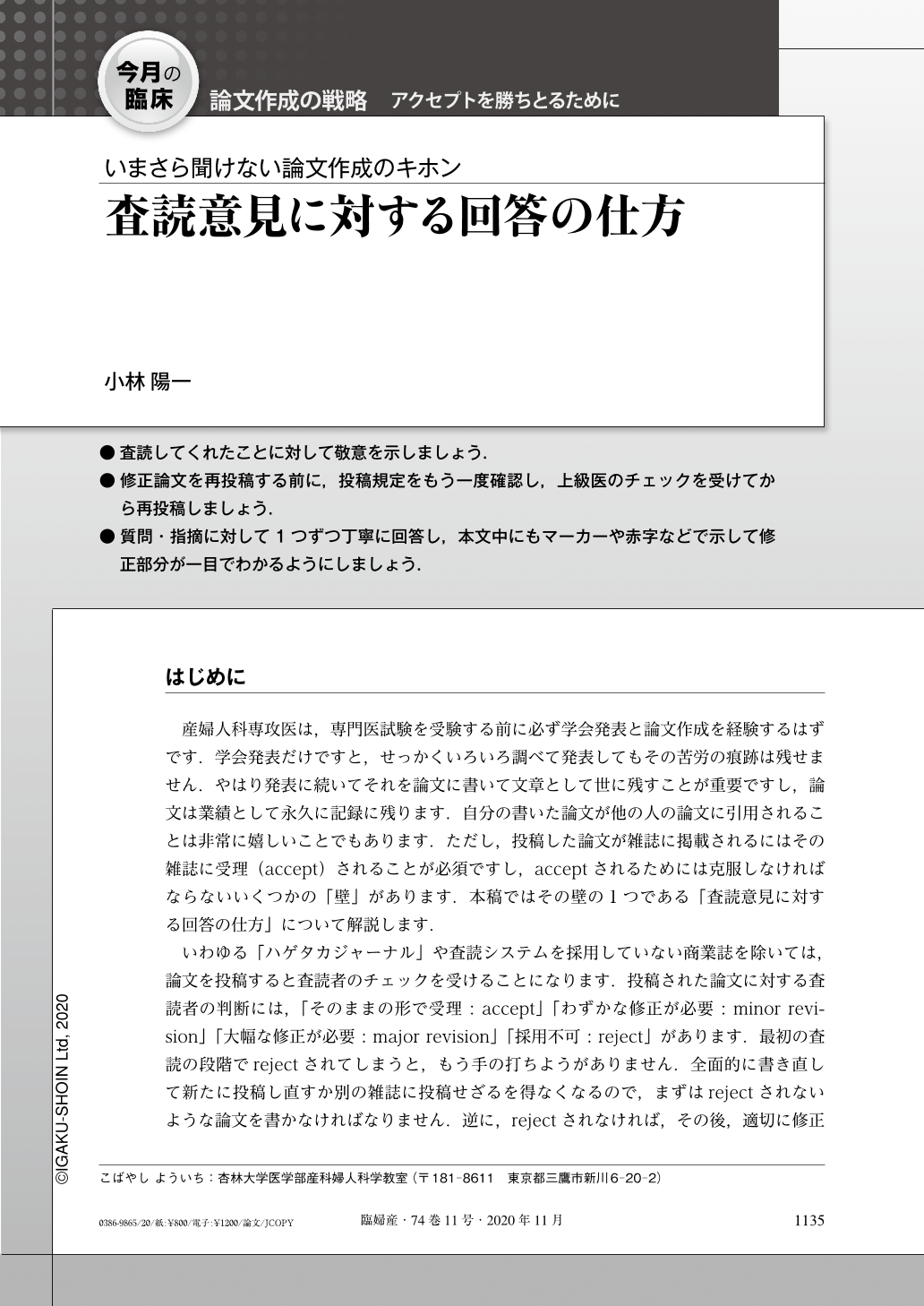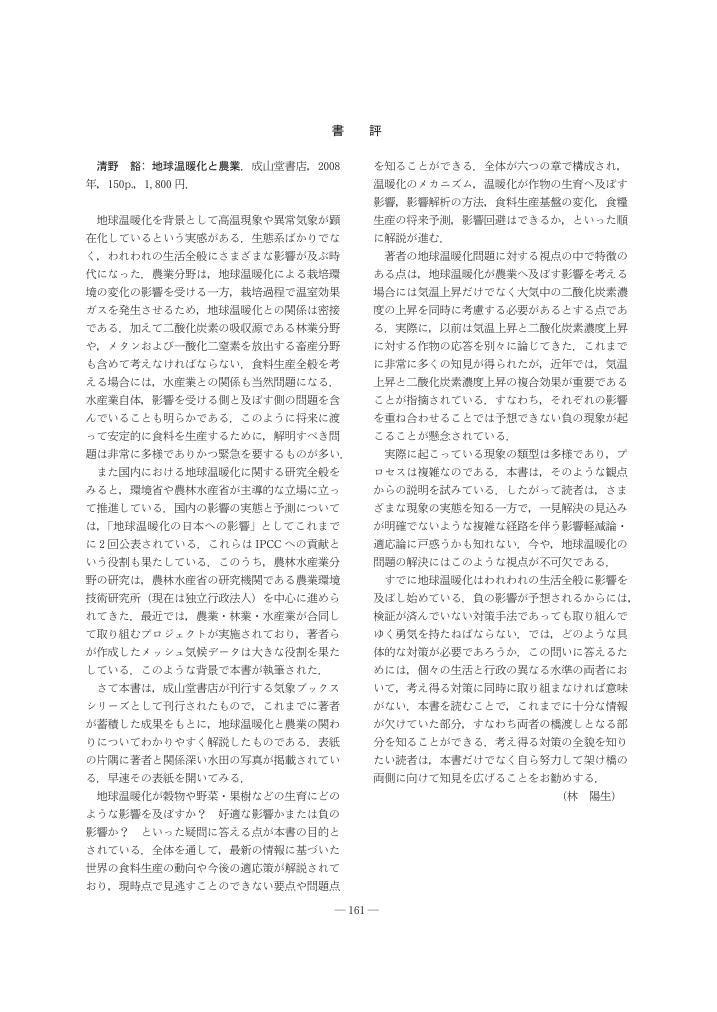- 著者
- 高林 陽展
- 出版者
- 績文堂出版
- 雑誌
- 歴史学研究 = Journal of historical studies (ISSN:03869237)
- 巻号頁・発行日
- no.994, pp.30-38, 2020-03
2 0 0 0 OA 非正規公務員と任用の法的性質
- 著者
- 上林 陽治
- 出版者
- 地方自治総合研究所
- 雑誌
- 自治総研 (ISSN:09102744)
- 巻号頁・発行日
- no.441, pp.1-31, 2015-07
2 0 0 0 OA 18 ビルディングの環境衛生調査結果について
- 著者
- 小林 陽太郎 森村 武雄 今井 隆雄 武藤 暢夫
- 出版者
- 社団法人空気調和・衛生工学会
- 雑誌
- 秋季学術講演会前刷集
- 巻号頁・発行日
- no.42, pp.71-74, 1967-10-27
- 著者
- 高林 陽展 タカバヤシ アキノブ Akinobu TAKABAYASHI
- 雑誌
- 清泉女子大学キリスト教文化研究所年報
- 巻号頁・発行日
- vol.22, pp.59-85, 2014-06-30
- 著者
- 林 陽子
- 出版者
- 日本子どもの虐待防止研究会
- 雑誌
- 子どもの虐待とネグレクト (ISSN:13451839)
- 巻号頁・発行日
- vol.2, no.2, pp.219-224, 2000-12
2 0 0 0 OA アメリカ経済の金融化と企業金融 : 事業再構築との関連で
- 著者
- 小林 陽介
- 出版者
- 経済理論学会
- 雑誌
- 季刊経済理論 (ISSN:18825184)
- 巻号頁・発行日
- vol.49, no.3, pp.90-95, 2012-10-20
- 被引用文献数
- 1
Recently there has been a great deal of research generated focusing on the Financialization-Approach. However, most of the literature on financialization emphasizes the influence of the financial sector, and pays less attention to the real economy. This paper examines how to bring the dynamism of real economy into the Financialization- Approach. Firstly, I investigate the relationship between corporations and finance, focusing on the literature of corporate governance. According to the research by Lazonick and O'Sullivan, the management strategy of U.S. corporations changed from "retain and reinvest" to "downsize and distribute" after the 1980s. U.S. corporations reduced their employment, and distributed cash to stockholders, and increased dividend payments and stock repurchases to raise their stock prices. This change arose from the formation of the "market for corporate control", which is explained mainly from the following: 1) Worsening performance of corporations and agency theory, 2) Increase of the stock holding by institutional investors, and 3) Development of junk bond market. However, this change is explained only from the influence of finance. The activeness of corporations is ignored. Secondly, I investigate the situation that U.S. corporations faced in 1980s to focus on the corporate action. They faced the shift in industrial structure. Key industries, such as steel, automobile and household electronic appliances, lost competitive power, while high-technology, energy and service industries maintained competitive power. Many corporations restructured their business formations to adapt to this shift by mergers and acquisitions. While raising stock prices is a result of financial influence in the literature of financialization, raising stock prices has a positive meaning for companies which perform mergers and acquisitions. Companies can perform mergers and acquisitions advantageously when their stock prices are high. Increase of dividend payments and stock repurchases can be understood to be a result of corporate action which adapts to the shift in industrial structure by mergers and acquisitions. Finally, I discuss the corporate image which should be included in the Financialization-Approach. The corporation should be assumed the active one which pursues profits, not the passive one assumed in the former literature. This is the starting point of an attempt to bring the dynamism of real economy into the Financialization-Approach.
- 著者
- 高林 陽展 タカバヤシ アキノブ Akinobu TAKABAYASHI
- 出版者
- 清泉女子大学
- 雑誌
- 清泉女子大学キリスト教文化研究所年報
- 巻号頁・発行日
- vol.22, pp.59-85, 2014
2 0 0 0 IR コーポレートベンチャーキャピタルにおける組織とパフォーマンス
- 著者
- 倉林 陽 クラバヤシ アキラ Kurabayashi Akira
- 出版者
- 同志社大学政策学会
- 雑誌
- 同志社政策科学研究 = Doshisha policy and managemant review (ISSN:18808336)
- 巻号頁・発行日
- vol.17, no.2, pp.35-51, 2016-03
論説(Article)米国のICT業界において、コーポレートベンチャーキャピタル(CVC)を活用したベンチャー企業との資本提携や、ベンチャー企業の買収によるR&Dの外部化は、事業開発上の標準的な手法として定着している。日本に於いても、近年大手企業によるCVCの設立が続くが、未だ米国程の成功を収めることのできた事例は少ない。本稿では、米国の先行研究を基にCVCの成功要因を抽出すると共に、日本のCVCの組織とパフォーマンスに関する実態調査を行い、米国CVCの成功要因が日本でも有効であるかどうかについて、分析を行った。In the US, IT companies used Open Innovation through Corporate Venture Capital (CVC) and M&A as a standard practice of corporate development to remain at the forefront of innovation. However in Japan, the number of successful CVC practices continues to be limited despite growing number of Japanese corporations launching a CVC practice. To explain this difference, this thesis first performed comprehensive review of US past researches regarding US CVC and sort out key success factors. Then, conducted a survey of Japanese CVC's organization profile and investment performance and undertook a statistical analysis to investigate whether US CVC's key success factors works in Japan.
- 著者
- 田坂 茂 林 陽佑 杉田 篤史
- 出版者
- 日本液晶学会
- 雑誌
- 日本液晶学会討論会講演予稿集
- 巻号頁・発行日
- no.2005, pp.107-108, 2005-09-05
1 0 0 0 OA 自治体相談支援業務と非正規公務員 その実態
- 著者
- 上林 陽治
- 出版者
- 公益財団法人 地方自治総合研究所
- 雑誌
- 自治総研 (ISSN:09102744)
- 巻号頁・発行日
- vol.46, no.498, pp.25-52, 2020 (Released:2020-12-02)
1 0 0 0 OA 専業非常勤講師という問題 ―大学教員の非正規化の進展とその影響―
- 著者
- 上林 陽治
- 出版者
- 社会政策学会
- 雑誌
- 社会政策 (ISSN:18831850)
- 巻号頁・発行日
- vol.12, no.3, pp.73-84, 2021-03-30 (Released:2023-03-30)
- 参考文献数
- 18
大学の非常勤講師のみで生計を立てるいわゆる専業非常勤講師は,1995年を境に大学教員における割合を高め,1998年には4万5370人(延べ数)だったものが2016年には9万3145人(延べ数)へと倍増し大学教員の3分の1を占めるに至った。これら専業非常勤講師は,週8コマ程度を受け持たない限り,年収300万円にも届かない高学歴ワーキングプアである。 増大の原因は,1991年から始まった大学院重点化計画による博士課程修了者の増加に見合う正規教員等の職が用意されなかったことにあるが,この問題が放置されたのは,正規「専務教員」が大学院重点化政策の過程で大学院へと移行し,少なくなった学士課程の「専務教員」の隙間を埋めるべく高学歴ワーキングプア層の専業非常勤講師が活用されていったことである。 すなわち大学経営は1990年代以降に政策的に生み出された高学歴ワーキングプアの専業非常勤講師を活用することで成り立っているのである。
- 著者
- 上林 陽治
- 出版者
- 立教大学コミュニティ福祉学会
- 雑誌
- まなびあい
- 巻号頁・発行日
- vol.15, pp.139-146, 2022-11-14
1 0 0 0 OA 会計年度任用職員白書 2020
- 著者
- 上林 陽治
- 出版者
- 公益財団法人 地方自治総合研究所
- 雑誌
- 自治総研 (ISSN:09102744)
- 巻号頁・発行日
- vol.47, no.514, pp.26-56, 2021 (Released:2021-08-30)
1 0 0 0 OA LiFePO4を用いた全固体型リチウムポリマー二次電池の基礎特性
- 著者
- 宮代 一 小林 陽 中村 龍哉 関 志朗 三田 裕一 宇佐美 章
- 出版者
- The Electrochemical Society of Japan
- 雑誌
- Electrochemistry (ISSN:13443542)
- 巻号頁・発行日
- vol.74, no.4, pp.321-325, 2006-04-05 (Released:2012-03-20)
- 参考文献数
- 23
- 被引用文献数
- 2 4
Olivine structured LiFePO4 cathode is the promising cathode active material for lithium secondary batteries due to its low cost and quite excellent reversibility. On the other hand, lithium polymer secondary batteries (LPBs) have been studied for the purpose of large-scaled batteries (for example, electric power load leveling). In this study, we prepared LPBs using the LiFePO4 cathode. By measuring the charge-discharge properties and electrochemical impedance spectroscopy, basic properties were investigated compared with the LPBs using the 4V-class LiCoO2 cathode.
1 0 0 0 OA 静脈管開存症の1例
1 0 0 0 査読意見に対する回答の仕方
- 著者
- 服部 和裕 山本 明美 笹井 みさ 谷内 昇一郎 小島 崇嗣 小林 陽之助 岩本 洋 難波 恭子 八重島 智子
- 出版者
- 一般社団法人 日本アレルギー学会
- 雑誌
- アレルギー (ISSN:00214884)
- 巻号頁・発行日
- vol.52, no.1, pp.20-30, 2003
- 被引用文献数
- 1
腸内にBifidobacteriumが少ないアトピー性皮膚炎患児15例を予備的な菌叢の検索から選択し,うち投与群8例に対してビフィズス菌凍結乾燥末(Bifidobacterium breve M-16V株)を経口投与した.腸内細菌叢の変動とアレルギー症状の推移を観察し,対照群7例と比較した.投与群では,ビフィズス菌末投与1カ月目の時点で,腸内のBifidobacterium占有割合の有意(P=0.0173)な上昇と,総好気性菌占有割合の有意(P=0.0499)な低下を認め,さらにアレルギー症状も有意(皮膚スコアでP=0.0176,総合スコアでP=0.0117)に改善した.一方,ビフィズス菌末の投与はアトピー性皮膚炎の症状改善を対照群に比較して有意に促進したが,自然排泄便を検体とした腸内細菌叢の変動と,アレルギー症状の推移の間には,明確な相関を認めなかった.
1 0 0 0 表層拡大部に二方向性分化を伴った肝外胆管原発腺扁平上皮癌の1例
- 著者
- 川合 亮佑 藤野 雅彦 宮田 完志 湯浅 典博 竹内 英司 後藤 康友 三宅 秀夫 永井 英雅 小林 陽一郎 伊藤 雅文
- 出版者
- 一般社団法人 日本消化器外科学会
- 雑誌
- 日本消化器外科学会雑誌 (ISSN:03869768)
- 巻号頁・発行日
- vol.44, no.5, pp.549-555, 2011
症例は73歳の男性で,66歳時に十二指腸乳頭部腺腫に対して内視鏡的乳頭切除術が施行されている.68歳時に悪性リンパ腫に対して化学療法を施行され完全寛解を得ている.平成20年9月,心窩部痛を主訴に当院を受診した.内視鏡的逆行性胆管膵管造影で総胆管結石と中部胆管の狭窄を認め,切石と狭窄部の生検,内視鏡的経鼻胆管ドレナージを行った.生検で腺癌と診断されたため,肝外胆管癌と診断し膵頭十二指腸切除術を施行した.胆管癌は肉眼的に乳頭浸潤型で表層拡大進展を呈した.病理組織学的に浸潤部はほとんど扁平上皮癌であったが,表層拡大進展部の粘膜内および線維筋層浸潤部に腺癌・扁平上皮癌の二方向性分化を認めた.また,固有筋層に浸潤する胆嚢癌も伴っていた.肝外胆管原発腺扁平上皮癌の本邦報告43例の中で,粘膜内で腺癌・扁平上皮癌の二方向性分化を認めた症例はなく,自験例は腺扁平上皮癌の組織発生を考察するうえで貴重な症例である.
1 0 0 0 IR 鉛に曝されたこころ : 近代イギリスにおける鉛製水道管の健康被害をめぐって (特集 病)
- 著者
- 高林 陽展
- 出版者
- 史学研究会 (京都大学大学院文学研究科内)
- 雑誌
- 史林 = The Journal of history (ISSN:03869369)
- 巻号頁・発行日
- vol.103, no.1, pp.103-143, 2020-01
一九世紀以降の西洋世界において、大気や土壌への放出量の増加、鉛を取り扱う労働現場の増加、食品加工時の鉛の利用、水道管への鉛の使用など、人は鉛への暴露の機会を大きく増やした。その結果生じる健康被害については、職業病や環境問題をあつかった諸研究で論じられてきた。また近年、社会経済史家W・トロスケンが、近現代の合衆国東岸やイングランド北部において水道水による鉛中毒が深刻だったことを論じている。一方、二〇世紀後半以降の医学研究は、低量の鉛暴露によって神経の発達や精神疾患への罹患リスクが高まることを主張してきた。本稿は、こうした諸研究をもとに、イングランド北部の西ヨークシャー、特にシェフィールドに絞って、精神疾患を中心とした健康被害の実態を検討し、同地域における深刻な鉛暴露の実態を明らかにした。ただし、人口統計や病院史料に基づく量的な分析においては、鉛暴露による健康被害は明確には認められなかった。
1 0 0 0 OA 清野 豁:地球温暖化と農業
- 著者
- 林 陽生
- 出版者
- 公益社団法人 日本地理学会
- 雑誌
- 地理学評論 Series A (ISSN:18834388)
- 巻号頁・発行日
- vol.82, no.2, pp.161a, 2009-03-01 (Released:2011-05-31)






